GIGABYTE Server GA-7PESH3 Motherboard Review
by Ian Cutress on September 4, 2014 2:00 PM EST- Posted in
- Motherboards
- Intel
- Gigabyte
- Xeon
- Workstation
- Enterprise
- C602
Many thanks to...
We must thank the following companies for kindly providing hardware for our test bed:
- Thank you to OCZ for providing us with PSUs and SSDs.
- Thank you to G.Skill for providing us with memory.
- Thank you to Corsair for providing us with an AX1200i PSU and a Corsair H80i CLC.
- Thank you to MSI for providing us with the NVIDIA GTX 770 Lightning GPUs.
- Thank you to Rosewill for providing us with PSUs and RK-9100 keyboards.
- Thank you to ASRock for providing us with some IO testing kit.
- Thank you to Cooler Master for providing us with Nepton 140XL CLCs.
- Thank you to GIGABYTE for providing us with the CPUs.
Test Setup
| Processor |
2x Intel E5-2697 v2 2x Intel E5-2687W v2 |
2x 12C/24T 2x 8C/16T |
2.7 GHz / 3.5 GHz 3.4 GHz / 4.0 GHz |
|
| Motherboard | GIGABYTE GA-7PESH3 | |||
| Cooling |
Corsair H80i Cooler Master Nepton 140XL |
|||
| Power Supply |
OCZ 1250W Gold ZX Series Corsair AX1200i Platinum PSU |
1250W 1200W |
80 PLUS Gold 80 PLUS Platinum |
|
| Memory | Kingston 8x4GB ECC | DDR3-600 | 11-11-11 1.5V | |
| Memory Settings | XMP | |||
| Video Cards | MSI GTX 770 Lightning 2GB (1150/1202 Boost) | |||
| Video Drivers | NVIDIA Drivers 337.88 | |||
| Hard Drive | OCZ Vertex 3 | |||
| Optical Drive | LG GH22NS50 | |||
| Case | Open Test Bed | |||
| Operating System | Windows 7 64-bit SP1 | |||
| USB 2/3 Testing | OCZ Vertex 3 240GB with SATA->USB Adaptor | |||
System Benchmarks
Power Consumption
Power consumption was tested on the system while in a single MSI GTX 770 Lightning GPU configuration with a wall meter connected to the OCZ 1250W power supply. This power supply is Gold rated, and as I am in the UK on a 230-240 V supply, leads to ~75% efficiency > 50W, and 90%+ efficiency at 250W, suitable for both idle and multi-GPU loading. This method of power reading allows us to compare the power management of the UEFI and the board to supply components with power under load, and includes typical PSU losses due to efficiency. These are the real world values that consumers may expect from a typical system (minus the monitor) using this motherboard.
While this method for power measurement may not be ideal, and you feel these numbers are not representative due to the high wattage power supply being used (we use the same PSU to remain consistent over a series of reviews, and the fact that some boards on our test bed get tested with three or four high powered GPUs), the important point to take away is the relationship between the numbers. These boards are all under the same conditions, and thus the differences between them should be easy to spot.
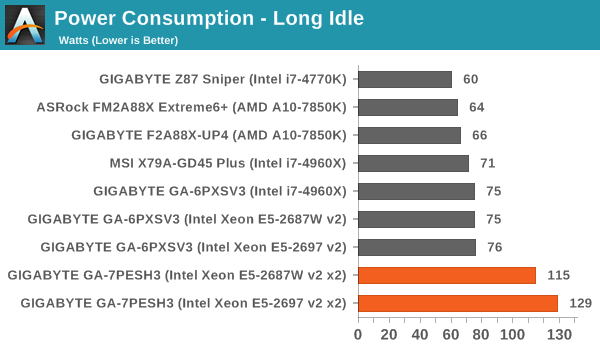
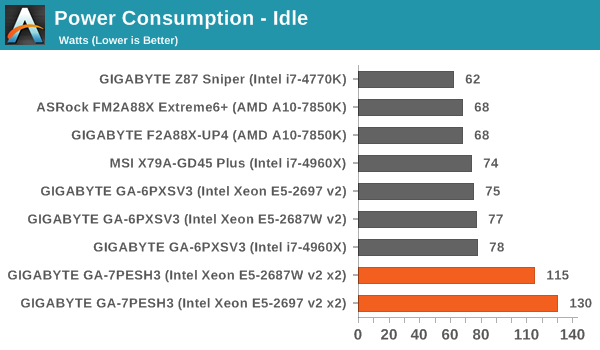
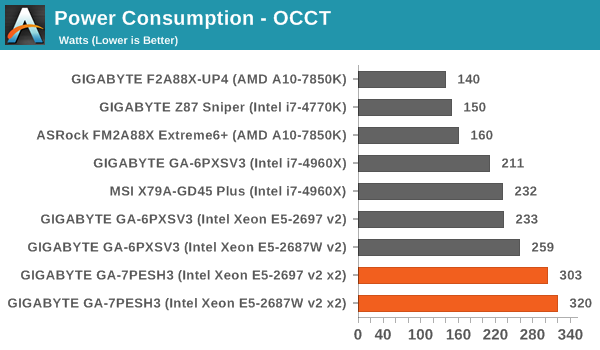
When we compare the system loads between one processor and two processors, it seems odd that the second processor does not seem to add much to the process at load but a good chunk while idle. Note we are comparing the single socket server motherboard to the GA-7PESH3, but it is still much of a jump. Idle power consumption on these boards is quite high, however these machines are built more for a 24/7 workload.
Windows 7 POST Time
Different motherboards have different POST sequences before an operating system is initialized. A lot of this is dependent on the board itself, and POST boot time is determined by the controllers on board (and the sequence of how those extras are organized). As part of our testing, we look at the POST Boot Time using a stopwatch. This is the time from pressing the ON button on the computer to when Windows 7 starts loading. (We discount Windows loading as it is highly variable given Windows specific features.)
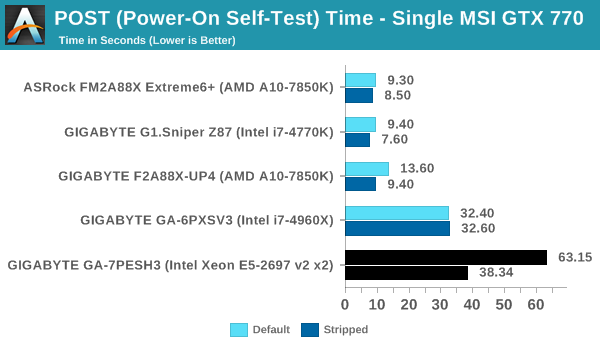
Like any other server-based motherboard we have ever tested, POST times are long. Half of this is going from pressing the ON button and the management software to do its thing before the CMOS takes over. Even then, the dual server-grade Intel NICs have their own integration sequence, along with the RAID subsystem. It all adds up, and that is why we can cut it down to under 40 seconds by disabling controllers if they are not in use.
Rightmark Audio Analyzer 6.2.5
Rightmark:AA indicates how well the sound system is built and isolated from electrical interference (either internally or externally). For this test we connect the Line Out to the Line In using a short six inch 3.5mm to 3.5mm high-quality jack, turn the OS speaker volume to 100%, and run the Rightmark default test suite at 192 kHz, 24-bit. The OS is tuned to 192 kHz/24-bit input and output, and the Line-In volume is adjusted until we have the best RMAA value in the mini-pretest. We look specifically at the Dynamic Range of the audio codec used on board, as well as the Total Harmonic Distortion + Noise.
Dynamic Range of the GIGABYTE GA-7PESH3
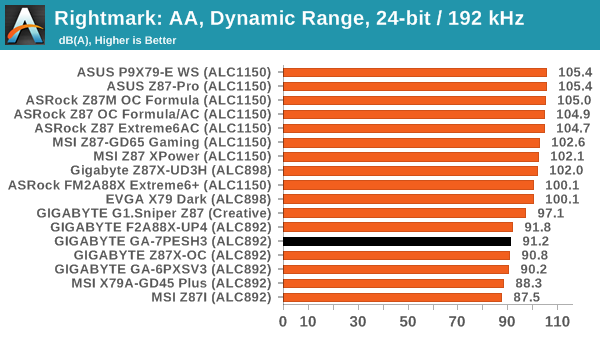
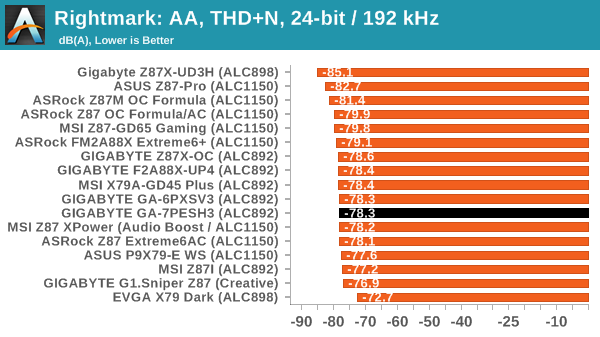
As the 7PESH3 is different to our previous 2P server motherboards in actually having motherboard audio, it should be applauded. The downside is that the ALC892 is the midrange 7.1 Realtek NIC, and is usually outperformed by the ALC898 and ALC1150. For a motherboard that costs $640, I am in two minds as to demand the higher codec. Audio might not be a target for a system like this, however the price demands something better than average.
USB Backup
For this benchmark, we transfer a set size of files from the SSD to the USB drive using DiskBench, which monitors the time taken to transfer. The files transferred are a 1.52 GB set of 2867 files across 320 folders – 95% of these files are small typical website files, and the rest (90% of the size) are small 30 second HD videos. In an update to pre-Z87 testing, we also run MaxCPU to load up one of the threads during the test which improves general performance up to 15% by causing all the internal pathways to run at full speed.
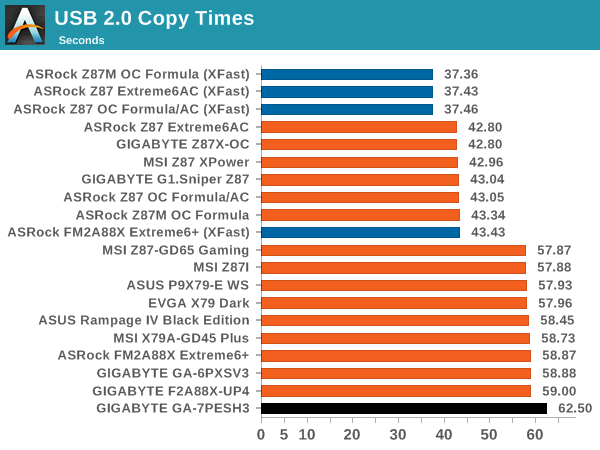
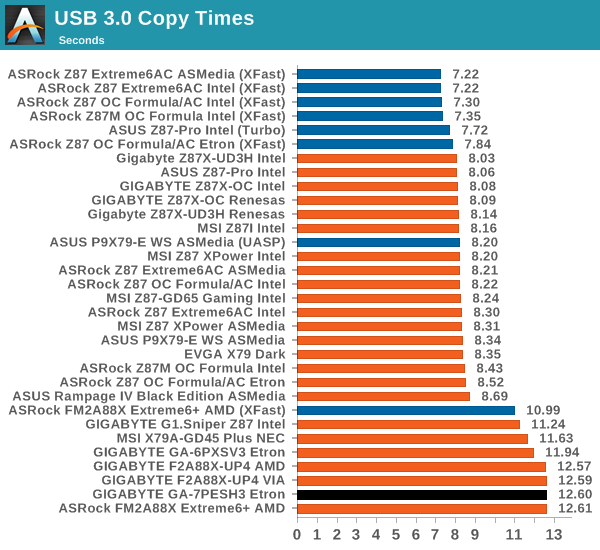
The consumer oriented business units at the major motherboard manufacturers have managed to implement a form of USB 2.0 (either in hardware or software) on their products to achieve around 43 seconds in our test. Those that have not implemented this difference hit around the 60 second mark, like the 7PESH3 does. The USB 3.0 also comes out slower than a consumer model due to the use of controllers.
DPC Latency
Deferred Procedure Call latency is a way in which Windows handles interrupt servicing. In order to wait for a processor to acknowledge the request, the system will queue all interrupt requests by priority. Critical interrupts will be handled as soon as possible, whereas lesser priority requests such as audio will be further down the line. If the audio device requires data, it will have to wait until the request is processed before the buffer is filled.
If the device drivers of higher priority components in a system are poorly implemented, this can cause delays in request scheduling and process time. This can lead to an empty audio buffer and characteristic audible pauses, pops and clicks. The DPC latency checker measures how much time is taken processing DPCs from driver invocation. The lower the value will result in better audio transfer at smaller buffer sizes. Results are measured in microseconds.
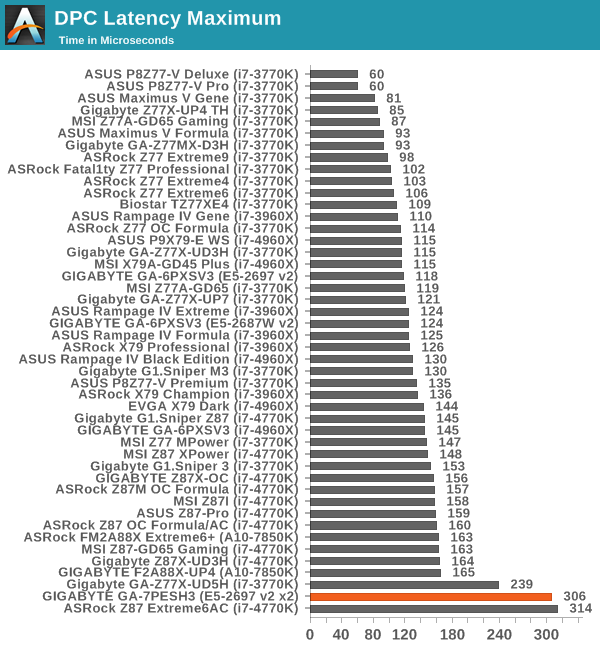
The DPC Latency for the 7PESH3 was a little odd:
The system seems to oscillate between ~100 microseconds and ~300 microseconds. Normally on most consumer motherboards this would happen due to the presence of an abnormal WiFi software stack, or an unoptimized BIOS. Server motherboards historically have done rather poor in this test, perhaps indicating that the server management tools constantly polling temperatures and fan speeds might be the contributing factor.



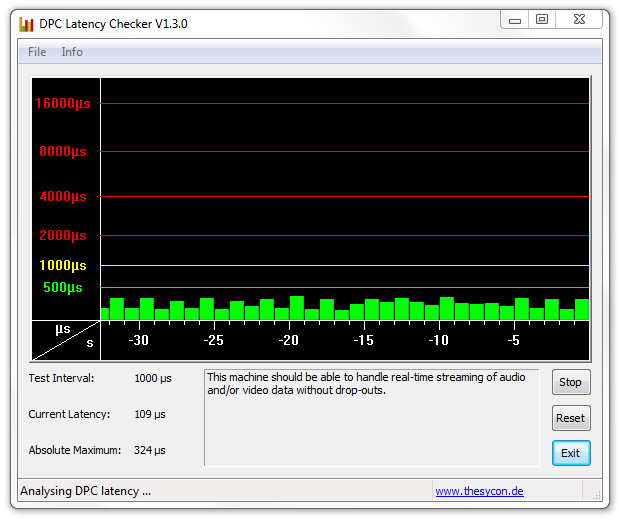








35 Comments
View All Comments
ShieTar - Friday, September 5, 2014 - link
Well, there is a tiny group of people who will be interested: They need a Workstation because they independently work with their PC to create content, but if possible they would also like to use the existing setup to game occasionally, instead of spend another 1k$ and put another Case next to their desk.Also, 10 years ago a lot of Trolls were posting "Yeah but can it run Quake" in the comment section of server hardware reviews. This kind of testing shuts them up.
xxsk8er101xx - Saturday, September 6, 2014 - link
Because the motherboard is designed for the prosumer market. Not the professional/server market. The point of the article is to basically say that this motherboard servers no purpose. It can't be used for the professional/server market because there are too few RAM slots and no mini-sas slots which the majority of the professional market has a need for.Kevin G - Sunday, September 7, 2014 - link
I think this motherboard has priced itself out of the prosumer market a bit at $650 USD and then you have Xeon prices on top of that. I do see this system being a decent pick for some professional tasks though. RAM capacity is still pretty decent as this board accepts 32 GB DIMMs for 256 GB capacity. That's a bit expensive due to 32 GB DIMM pricing but I see 128 GB via 16 GB DIMMs as reasonably priced for what you get. Needing more than 128 GB is a very small niche and one that overlaps widely with the idea of just using servers to batch process the large data sets anyway.The PCIe setup does scream professional though. Components like capture cards and PCIe SSDs are not going to be restricted in performance. (Though it is worrisome that this board doesn't have a dedicated aux power for just the PCIe slots.) The presence of onboard audio also indicates that this certainly isn't a server board.
I have yet to encounter a good reason for SAS in the professional space. 6 Gbit SATA provides enough bandwidth and SSD's can saturate that. SATA hard drives are adequate for bulk storage locally. (There is definitely a niche for SAS in server space with multi path IO for redundancy.) I can see a need for RAID5/6 in the prosumer and professional space but SAS isn't a requirement for it (though incidentally most RAID5/6 cards are SAS based). Even then, in most cases software RAID1 is 'good enough' for redundancy to prevent downtime in the professional space.
AnnihilatorX - Sunday, September 7, 2014 - link
Kindly read the article!: "While gaming is not a focus of motherboards like the GIGABYTE GA-7PESH3, the system may be in use by content developers relying on an accurate representation with what they are making. "gchernis - Thursday, September 4, 2014 - link
Nice write-up! Do you have any data on total CPU utilization with multithreaded tasks? What about kernel-time vs. user mode time split?JellyRoll - Thursday, September 4, 2014 - link
"Server motherboards historically have done rather poor in this test,"....perhaps because it is a server motherboard? are you testing a server workload on it?Samus - Thursday, September 4, 2014 - link
Anand used to do SQL benchmarks. This is what we need for this review to be complete.mavere - Thursday, September 4, 2014 - link
The Handbrake results are a bit disappointing because data-dependency breakpoints occur both naturally (at scene boundaries) and manually (at regular ~10s key-frame intervals). Conceptually, the transcoder can easily reuse the source's chapter-timing metadata and keyframes to outsource chunks of work to each socket with minimal communication overhead.I'm guessing that NUMA performance was never a pressing concern for any of Handbrake's and x264's contributors.
JDG1980 - Thursday, September 4, 2014 - link
I just can't see a good reason to buy into Ivy Bridge at this time, when Haswell-EP is just around the corner. Personally, I'm seriously considering the E5-1650 v3, assuming it comes in at a similar price point to its predecessor (and assuming that there are some decent workstation boards with ECC support available).And it's especially hard for AnandTech to justify the time reviewing this soon-to-be-obsolescent board when they still haven't gotten around to Tonga. I know it's not the most groundbreaking new GPU design (and AMD picked about the worst place in their lineup they possibly could to slot it), but still, it's a new GPU and we haven't seen a review despite every other major site doing so 2 days ago. What's going on with this?
ruthan - Thursday, September 4, 2014 - link
I would buy such machine for gaming if there would be performance benefit, so its good to know and mainstream everytime rules.. Its like SPARC or Power architecture, they cant compete because of mainstream x86 market is huge so, research revenue there are also huge, users requirements are bigger, more universal. This Sparc, Ithanium or Power market exist only because of stupid company policies, like everything from one company, support only for this HW, lies about super duper optimalisation for such HW, and especially license per CPU socket (here realy doesnt matter about price of CPU because, SW licence per socket is astronomical, so you are forced to buy Sparc or Power machine..).